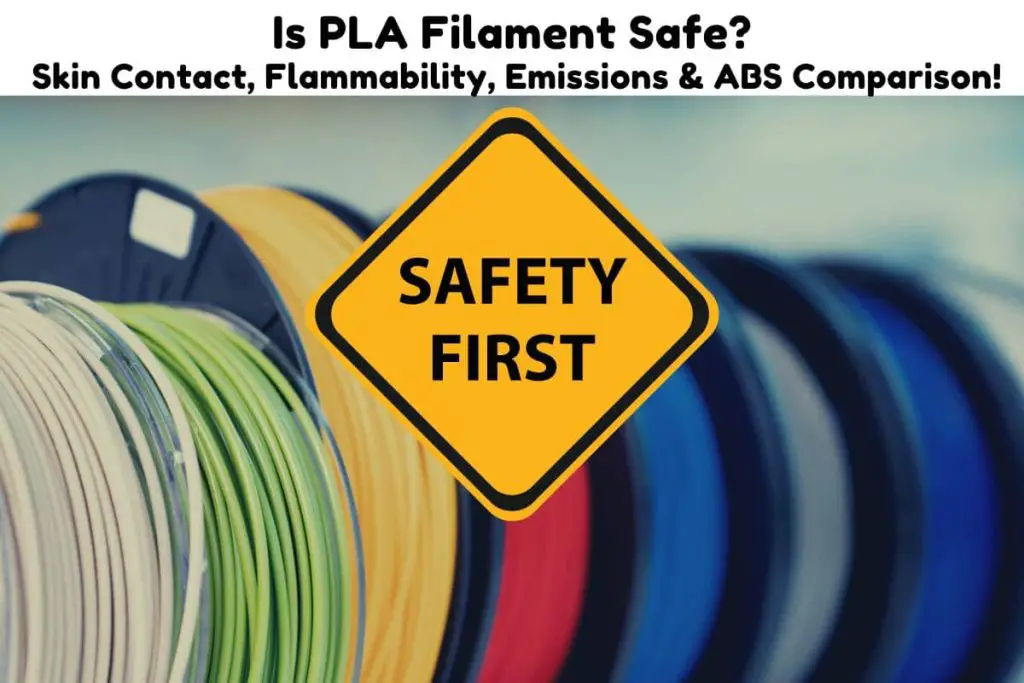PLA is without a doubt the most popular filament choice for many makers. Its low extrusion temperature makes it easy to use, making it perfect for rapid prototyping.
Another standout characteristic of PLA is its material composition. Unlike most plastics, PLA is not petroleum based. Instead, PLA is made from natural materials. This makes it a much safer filament to print with.
So, is PLA Filament Toxic? PLA is non-toxic in solid form. This is because it is made with organic materials like cornstarch as its primary component. This is in contrast to other types of filament like ABS or Nylon that are made from petroleum deemed PLA safe and positioned it as the safest filament available for use in 3D printing.
But just how safe is PLA? Is it safe to touch or breathe? How does it compare in terms of safety against a similarly popular filament like ABS for example? These are the questions we want to get into in this article.
On a side note! If you’re looking for a reliable and high-quality 3D printer, we highly recommend the Official Creality Ender 3 V2 Upgraded 3D Printer (Amazon Link).
This printer is an upgraded version of the popular Ender 3 model, with a range of new features and improvements that make it even easier and more convenient to use.


How is PLA made?
PLA or polylactic acid is made from the lactic acid units that are found in everyday foods like corn or maize as it’s known in some parts of the world. PLA is thus a plant-based filament.
The lactic acid in PLA is extracted from glucose rich plants before being mixed with other additives to produce dextrose (sugar). Fermenting the sugar produces lactic acid monomers which are used to make PLA through the process of polymerization or condensation.
Because it is plant and not petroleum-based, PLA breaks down easier. It is a much more biodegradable plastic compared to alternative polymers. This, and being cheaper to produce, is why PLA has become the second most used bio-plastic.
Today it is used to produce everything from plastic cups, plates to some of the disposable shrink-wrap our electronics come in. Source
The flammable filament
While on the subject of the toxicity of PLA, we would be negligent if we didn’t at least touch on its combustibleness. While it is the least toxic filament it also happens to be the most flammable. PLA will ignite if heated to temperatures over 270 degrees Celsius (518 degrees Fahrenheit).
This is why PLA is unsuited for making things like machine engine components that are exposed to high temperatures.
Is PLA Toxic To Breathe?
Like most thermoplastics, PLA produces toxic fumes when burned. PLA releases Volatile Organic Carbon (VOC) which is toxic when inhaled. It does, however, have the advantage of producing less harmful toxins because it is a plant-based polymer.
PLA is made from glucose extracted from cornstarch and sugarcane. This is why it smells “sweet” when it is extruded from a printer. With that said, glucose isn’t the only ingredient present in PLA. Additives are used during processing to alter or improve characteristics like color and printing performance.
On its own lactic based PLA may not be as toxic. The additives, as necessary as they might be, increase its toxicity. PLA Plus, which is meant to be a stronger upgrade on regular PLA, for example uses impact modifier additives to improve its impact resistance and make it less brittle. Source
There are several types and brands of PLA. They will naturally differ in chemical composition among different brands as manufacturers try to create stronger blends. When choosing a PLA filament, it’s worth noting how “pure” it is in terms of using fewer additives. A purer filament with less additives is likely to be less toxic.
We also highly recommend that you check out our post Do 3D Printers Cause Cancer? Risk & What You Must Know!
How to Make Printing with Pla Safer ?
While printing with PLA carries relatively low risk due to the minimal toxicity of PLA, there are several steps you can take to further reduce the risk of harmful inhalation.
- Print outdoors or away from your living spaces. A good example is a garage or shed.
- Make sure the printing area is well ventilated.
- Use a 3D printer enclosure.
- Use an air purifier.
- Use an air quality monitor to watch the VOC levels in your printing area.
- Use a simple fan.
For more on this, check out our post ” Do 3D Printers Need To Be Vented? What Every Owner Must Know!“
Also, check out our post “Where To and Not To Place A 3D Printer In Homes And Schools? Potential Risks!“
Is PLA Safe To Touch?
PLA is used to produce products that are commonly touched and is considered to be very safe to touch. It is used to produce food containers like water bottles. But one of the specific applications in which PLA shines is medicine. PLA is used to make medical implants and prosthesis like screws, fillers, pins, plates and stitching thread that biodegrade within the body.
It is this application that has made certain types of surgeries and implants less invasive than they once were. For instance, sutures (stitches) no longer need to be removed after a skin tear has healed. Sutures made from PLA are absorbed into the body as the wound heals.
Here is our selected quality PLA filament to use (Amazon Link)

Is Pla Safer than Abs?
Filament releases Volatile Organic Carbon (VOC) and UltraFine Particles (UFP). ABS filament can release up to 30 times more of these toxic fumes than PLA. The reduced toxicity of PLA is due to its more natural composition compared to ABS.
Find out more in our post ” How Much Carbon Monoxide Does 3D Printing Emit? Here Is What You Should Do About it!“
What is ABS made of?
Acrylonitrile Butadiene Styrene (ABS) is a petroleum-based polymer. It is the second most popular type of filament after PLA. Unlike PLA, ABS can withstand high temperatures. It also has better strength and durability.
These characteristics make it a slightly better filament than PLA. It is, however, harder to print with, hence why it plays second fiddle to PLA in terms of use.
Early research from the 1990s established the toxicity of processing plastics. During processing toxic chemicals like ammonia and benzene among others are released. Volatile Organic Compounds are a mixture of toxic chemicals with a high vapor pressure.
Ultra Fine Particles are tiny particles of less than a micron in diameter. Both VOCs and UFPs are released by filament during printing and are harmful when inhaled. PLA, however, produces smaller amounts of each of these compounds.
ABS releases both at much higher levels. In a recent study, ABS was found to produce between 3 to 30 times more VOCs and UFPs than PLA. The study also revealed that air quality can take up to 30 minutes to clear of UFPs after printing.
When inhaled, these compounds can cause short-term illness like headaches, fatigue or nausea. Long-term exposure has been linked to more serious illnesses like bronchitis, asthma and even certain types of cancer. Source

